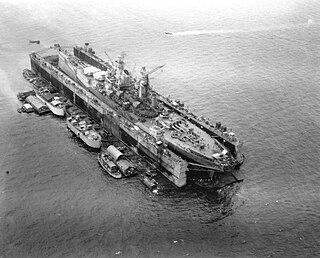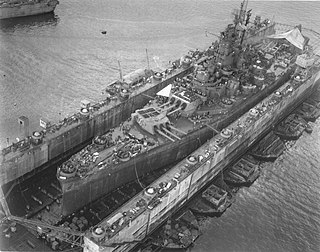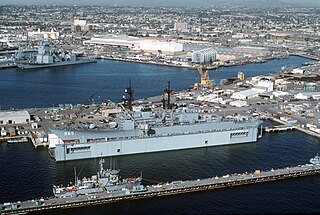
USS Artisan (ABSD-1), later redesignated as (AFDB-1), was a ten-section, non-self-propelled, large auxiliary floating drydock of the United States Navy. The only U.S. warship with this name, Artisan was constructed in sections during 1942 and 1943 by the Everett-Pacific Shipbuilding & Dry Dock Company, in Everett, Washington; the Chicago Bridge & Iron Company, in Eureka, California; the Pollock-Stockton Shipbuilding Company, in Stockton, California; and the Chicago Bridge & Iron Company, in Morgan City, Louisiana. This ship was commissioned at Everett, Washington, on 10 May 1943, Captain Andrew R. Mack in command. With all ten sections joined, she was 927 feet long, 28 feet tall, and with an inside clear width of 133 feet 7 inches.

USS Sculptor (AK-103) was a Crater-class cargo ship commissioned by the US Navy for service in World War II. Sculptor was named after the constellation Sculptor. She was responsible for delivering troops, goods and equipment to locations in the Asiatic-Pacific Theater.

USS Dewey (YFD-1) was a floating dry dock built for the United States Navy in 1905, and named for American Admiral George Dewey. The auxiliary floating drydock was towed to her station in the Philippines in 1906 and remained there until scuttled by American forces in 1942, to prevent her falling into the hands of the invading Japanese.

USS Adept (AFD-23) was a AFDL-1-class small auxiliary dry dock of the United States Navy Auxiliary floating drydock built for World War II.

An auxiliary floating drydock is a type of US Navy floating dry dock. Floating dry docks are able to submerge underwater and to be placed under a ship in need of repair below the water line. Water is then pumped out of the floating dry dock, raising the ship out of the water. The ship becomes blocked on the deck of the floating dry dock for repair. Most floating dry docks have no engine and are towed by tugboats to their destinations. Floating dry docks come in different sizes to accommodate varying ship sizes, while large floating dry docks come in sections and can be combined to increase their size and lift power. Ballast pontoon tanks are flooded with water to submerge or pumped dry to raise the ship.

YFD-2 was an auxiliary floating drydock built for the United States Navy in 1901. The first parts were laid down in early 1901 at Maryland Steel Co. of Sparrows Point, Maryland. YFD-2 was the first of its kind, steel movable auxiliary floating drydock, used to raise large ships out the water for repair below the ship's waterline. YFD-2 had a 18,000 tons lifting capacity.

USS AFDM-2,, is an AFDM-3-class medium auxiliary floating drydock built in Mobile, Alabama by the Alabama Drydock and Shipbuilding Company for the U.S. Navy. Originally named USS YFD-4, Yard Floating Dock-4, she operated by Todd Shipyards at New Orleans, Louisiana for the repair of US ships during World War II. YFD-4 was renamed an Auxiliary Floating Dock Medium AFDM-2 in 1945 after the war.

USS ABSD-2, later redesignated as AFDB-2, was a ten-section, non-self-propelled, large auxiliary floating drydock of the US Navy. Advance Base Sectional Dock-2 was constructed in sections during 1942 and 1943 by the Mare Island Naval Shipyard in Vallejo, California for World War II. Her official commissioning ceremony took place on 14 August 1943 with CDR. Joseph J. Rochefort in command. With all ten sections joined, she was 927 feet long, 28 feet tall, and with an inside clear width of 133 feet 7 inches. ABSD-2 had a traveling 15-ton capacity crane with an 85-foot radius and two or more support barges. The two side walls were folded down under tow to reduce wind resistance and lower the center of gravity. ABSD-2 had 6 capstans for pulling, each rated at 24,000 lbf (110,000 N) at 30 ft/min (0.15 m/s), 4 of the capstans were reversible. There were also 4 ballast compartments in each section.

ABSD-3 is an advanced base sectional dock, constructed of nine advance base dock (ABD) sections for the US Navy as an auxiliary floating drydock for World War II. ABSD-3 was delivered to the US Navy in April 1944, and was commissioned on 27 October 1944. Advance Base Sectional Dock-3 was constructed in sections during 1942 and 1943.

ABSD-6 is an advanced base sectional dock which was constructed of nine advance base docks (ABD) sections for the US Navy as an auxiliary floating drydock for World War II. ABSD-6 was built by Mare Island Naval Shipyard at Vallejo, California. ABSD-6 was commissioned on 28 September 1944. Advance Base Sectional Dock-6 was constructed in sections during 1942 and 1943. Each section are 3,850 tons and are 93 feet long each. Each Section had a 165 feet beam, a 75 feet molded depth and had 10,000 tons lifting capacity each. There were 4 ballast compartments in each section. With all nine sections joined, she was 825 feet long, 28 feet tall, and with an inside clear width of 133 feet 7 inches. ABSD-2 had a traveling 15-ton capacity crane with an 85-foot radius and two or more support barges. The two side walls were folded down under tow to reduce wind resistance and lower the center of gravity. ABSD-6 had 6 capstans for pulling, each rated at 24,000 lbf (110,000 N) at 30 ft/min (0.15 m/s), 4 of the capstans were reversible.

USS ABSD-4, later redesignated as AFDB-4, was a nine-section, non-self-propelled, large auxiliary floating drydock of the US Navy. Advance Base Sectional Dock-4 was constructed in sections during 1942 and 1943 by the Mare Island Naval Shipyard in Vallejo, California for World War II. With all ten sections joined, she was 927 feet long, 28 feet tall, and with an inside clear width of 133 feet 7 inches. ABSD-4 had a traveling 15-ton capacity crane with an 85-foot radius and two or more support barges. The two side walls were folded down under tow to reduce wind resistance and lower the center of gravity. ABSD-4 had 6 capstans for pulling, each rated at 24,000 lbf (110,000 N) at 30 ft/min (0.15 m/s), 4 of the capstans were reversible. There were also 4 ballast compartments in each section.

USS ABSD-5, later redesignated as AFDB-5, was a nine-section, non-self-propelled, large auxiliary floating drydock of the US Navy. Advance Base Sectional Dock-5 was constructed in sections during 1943 and 1944 by the Chicago Bridge & Iron Company in Morgan City, Louisiana for World War II. With all nine sections joined, she was 825 feet long, 28 feet tall, and with an inside clear width of 133 feet 7 inches. ABSD-5 had two traveling 15-ton capacity crane with an 85-foot radius and two or more support barges. The two side walls were folded down under tow to reduce wind resistance and lower the center of gravity. ABSD-5 had 6 capstans for pulling, each rated at 24,000 lbf (110,000 N) at 30 ft/min (0.15 m/s), 4 of the capstans were reversible. There were also 4 ballast compartments in each section.
Everett-Pacific Shipbuilding & Dry Dock Company was established in 1942 to build ships needed for World War II. As part of the Emergency Shipbuilding Program the US Navy provided some of the capital to start Everett-Pacific Shipbuilding at Port Gardner Bay in Everett, Washington. Everett-Pacific was sold in 1945 to the Pacific Car and Foundry, who was already a major manufacturer of railcars and trucks. Pacific Car and Foundry was building barges for the US Navy during World War II at plants in Renton, Seattle and Tacoma in the state of Washington. The lease for the shipyard in Everett, Washington ended in 1949 and the yard closed. Pacific Car and Foundry in 1972 changed its name to Paccar Inc. to reflect its major products. The Everett-Pacific shipyard site later became part of Western Gear, a heavy machinery manufacturer. in 1987 the shipyard became part of Naval Station Everett. Everett-Pacific Shipbuilding was started by William Pigott Jr. a Seattle businessmen and his brother Paul Pigott (1900-1961). William Pigott Jr. was born in 26 Aug. 1895 in Pueblo, CO and died on 8 July 1947 in San Francisco, CA.
Pollock-Stockton Shipbuilding Company was established in 1942 to build ships needed for World War II. As part of the Emergency Shipbuilding Program the US Navy provided some of the capital to start Pollock-Stockton Shipbuilding at Stockton, California. The shipyard was located at San Joaquin River and Stockton Channel, near Louis Park. After the war the shipyard closed down in February 1946.

USS Resourceful (AFDM-5),, was a AFDM-3-class floating dry dock built in 1943 and operated by the United States Navy.

USS AFDM-3,, was the lead ship of the AFDM-3-class floating dry dock built in 1943 and operated by the United States Navy.

USS Competent (AFDM-6),, was an AFDM-3-class floating dry dock built in 1943 and operated by the United States Navy.

The USS Sustain (AFDM-7),, was a AFDM-3-class floating dry dock built in 1945 and operated by the United States Navy.

USS Resolute (AFDM-10),, was a AFDM-3-class floating dry dock built in 1945 and operated by the United States Navy.

USS Steadfast (AFDM-14) is a AFDM-14-class floating dry dock built in 1945 and operated by the United States Navy.
















